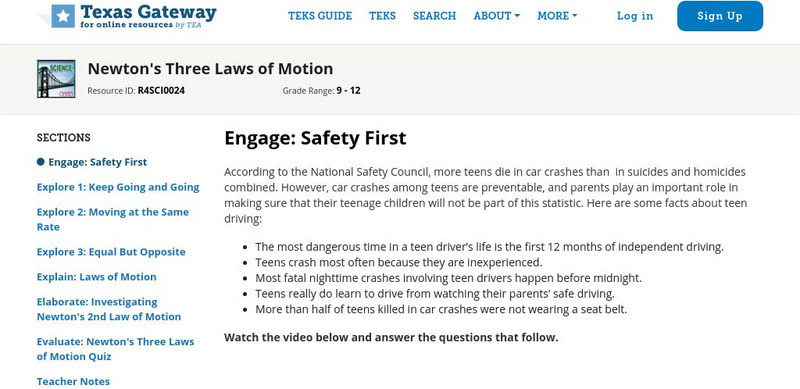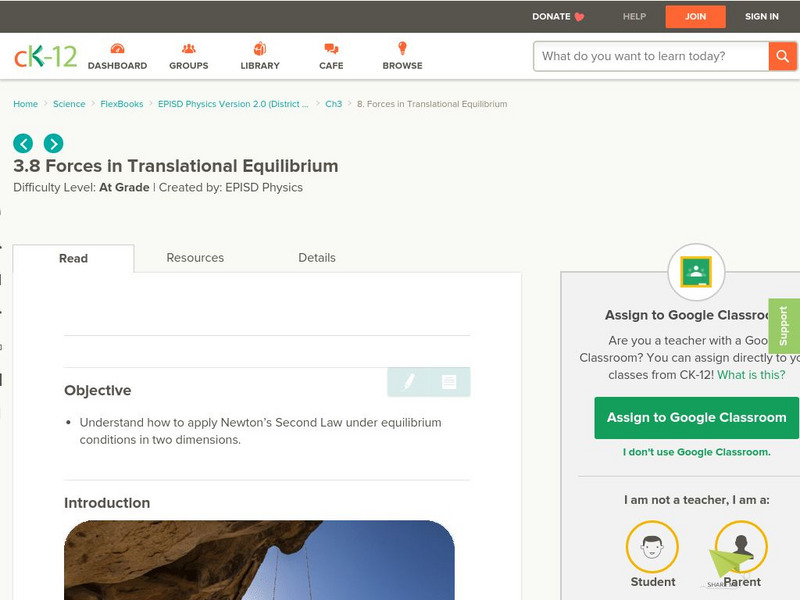Chicago Children's Museum
Simple Machines: Force and Motion
Get things moving with this elementary science unit on simple machines. Through a series of nine lessons including teacher demonstrations, hands-on activities, and science experiments, young scientists learn about forces, motion,...
Henry Ford Museum
Physics, Technology and Engineering in Automobile Racing
Start your engines! This five-lesson unit introduces physics and Newton's laws through automobile racing. Each lesson includes background information, a student worksheet, and an answer key. There are also culminating...
Texas Education Agency
Texas Gateway: Newton's Three Laws of Motion
This resource provides alternate or additional learning opportunities for students learning the three Newton's Laws of Motion. It includes a collection of interactive materilas, videos, and other digital media.
TED Talks
Ted: Ted Ed: Newton's 3 Laws, With a Bicycle
This video describes Newton's three laws of motion and how they relate to the everyday motion of a bicycle. [3:33] Followed by a short quiz and a list of additional resources to explore.
TeachEngineering
Teach Engineering: What Are Newton's Laws?
Through a series of three lessons and one activity, students are introduced to inertia, forces, and Newton's three laws of motion.
Georgia Department of Education
Ga Virtual Learning: Ap Physics 1: Newton's Laws of Motion
Newton's three laws are deceptively simple, but they are the underpinning of all of physics and govern the mechanics all of your actions in everyday life. Take an in-depth look at these laws in this learning module.
Texas Education Agency
Texas Gateway: Force and Newton's Laws: Section Summary
This page summarizes each section of Chapter 4: Dynamics: Force and Newton's Laws of Motion in the AP Physics online text. These include Newton's three laws of motion and application of those and other forces.
Physics Classroom
The Physics Classroom: The Apple, the Moon, and the Inverse Square Law
Describes the logic behind the development of Newton's law of universal gravitation. Beginning with Johannes Kepler and his three laws of planetary motion, content walks the reader through Newton's thought process and development of this...
TeachEngineering
Teach Engineering: Mechanics Mania
Through ten lessons and numerous activities, students explore the natural universal rules engineers and physicists use to understand how things move and stay still. Together, these rules are called "mechanics." The study of mechanics is...
TeachEngineering
Teach Engineering: Rockets
This unit teaches students how and why engineers design satellites to benefit life on Earth as well as allows students an opportunity to explore motion, rockets and rocket motion. Students discover that the motion of all objects...
Concord Consortium
Concord Consortium: Newton's Laws at the Atomic Scale
Explore how Newton's three laws apply to the world of atoms and molecules. Start with the originally contradictory observation of Brownian motion. Then, each law is addressed at the atomic level.
Georgia Department of Education
Ga Virtual Learning: A Brief History of Astronomy
In this interactive module students will explore what different ancient cultures believe was an explanation of the stars and planets. They will look at how the work of Nicolas Copernicus revolutionize the world of astronomy and learn how...
TED Talks
Ted: Ted Ed: If Superpowers Were Real: Flight
Is it scientifically possible to fly? In this series, creator Joy Lin tackles six superpowers and reveals just how scientifically realistic they can be to us mere mortals. [5:11]
CK-12 Foundation
Ck 12: Forces in Translational Equilibrium
[Free Registration/Login may be required to access all resource tools.] The following tutorial helps students to understand how to apply Newton's Second Law under equilibrium conditions in two dimensions.











